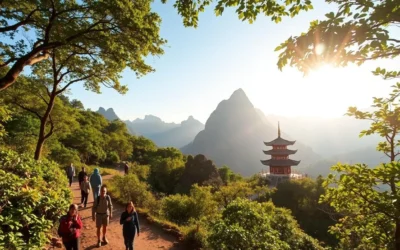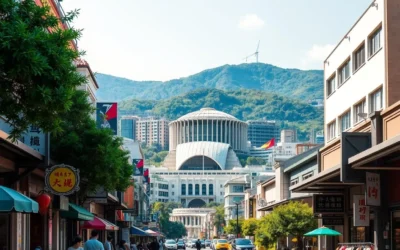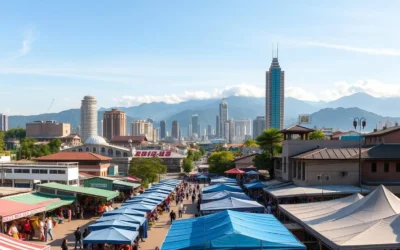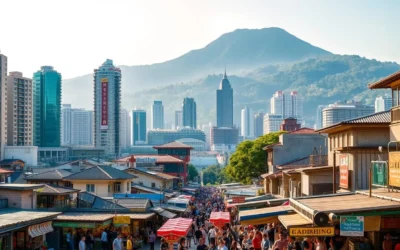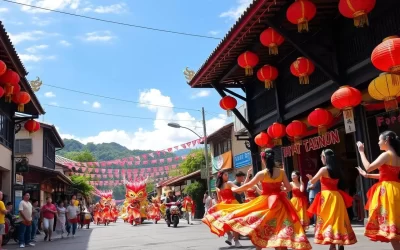✓ Accommodations✓ Flights✓ Rental Cars✓ Tours & Activities
When planning your next adventure, timing is everything. The best time to explore this vibrant destination is between October and April. During these months, you’ll enjoy comfortable temperatures and lower humidity, making it ideal for outdoor activities.
The climate varies across the island, from subtropical in the north to tropical in the south. This diversity means you can experience everything from cool mountain breezes to warm beach days in a single trip. Winter is perfect for hot springs and cherry blossoms, while autumn offers clear skies and pleasant weather.
Seasonal events and festivals add an extra layer of excitement to your travel plans. Whether it’s the Lunar New Year or local flower festivals, there’s always something to celebrate. Ready to dive deeper? Let’s explore the regional differences and tips to make your trip unforgettable.
Understanding Taiwan’s Diverse Climate
From subtropical north to tropical south, the island’s climate is full of surprises. This diversity means you can experience a range of weather patterns, even within a compact area. Whether you’re exploring bustling cities or serene mountains, understanding these variations will help you plan better.
Subtropical North vs. Tropical South
The northern part of the island, including Taipei, has a subtropical climate. This means cooler winters with temperatures dipping to the mid-50s°F and humid summers reaching up to 90°F. In contrast, the southern region, like Kaohsiung, enjoys a tropical climate with warmer, drier conditions year-round. July temperatures in the south can soar to 97°F, while winter lows rarely fall below 59°F.
Rainfall also varies significantly. Taipei receives an average of 95 inches annually, with September being the wettest month. Meanwhile, Kaohsiung sees about 13 inches of rain between June and August. These differences make the north ideal for lush greenery and the south perfect for sunny beach days.
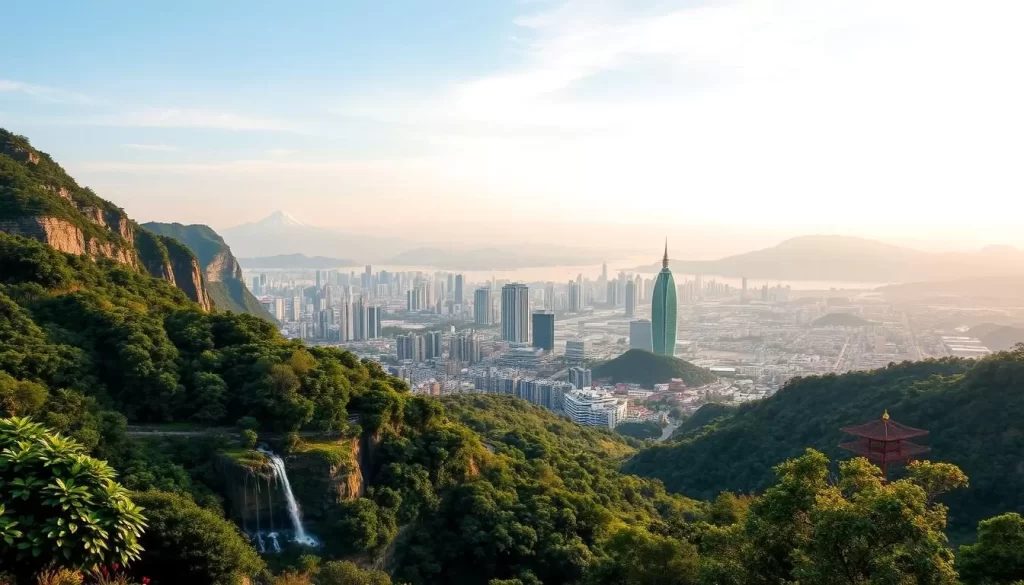
Regional Microclimates and Weather Variations
Even within regions, microclimates create unique weather patterns. The mountainous interior, for example, experiences cooler temperatures year-round. In July and August, highs average around 55°F, while winter lows can drop to 23°F. This makes the mountains a great escape from the summer heat.
Coastal areas, on the other hand, enjoy milder conditions. The east coast often sees more rainfall due to its exposure to ocean winds, while the west coast remains relatively dry. These variations influence everything from outdoor activities to festival timings, so it’s worth considering when planning your trip.
| Region | Climate Type | Average Temperature (°F) | Rainfall (Inches) |
|---|---|---|---|
| Taipei (North) | Subtropical | 55°F – 90°F | 95 |
| Kaohsiung (South) | Tropical | 59°F – 97°F | 13 (June-August) |
| Mountain Interior | Cool Temperate | 23°F – 55°F | Varies |
These regional differences mean you can tailor your trip to suit your preferences. Whether you’re chasing sunny skies or cool mountain breezes, the island has something for everyone.
Seasonal Highlights for a Weather-Savvy Trip
Each season brings its own magic, making it a year-round haven for travelers. Whether you’re drawn to cozy winter escapes or vibrant spring blooms, there’s something for everyone. Let’s dive into the seasonal highlights that make this destination unforgettable.
Winter Wonders: Hot Springs and Festivals
Winter is the perfect time to unwind in natural hot springs like Beitou and Wulai. With average temperatures ranging from 16°C in the north to 23°C in the south, it’s a cozy escape from the chill. This season also brings festive celebrations like the Lantern Festival and Lunar New Year, adding cultural richness to your trip.
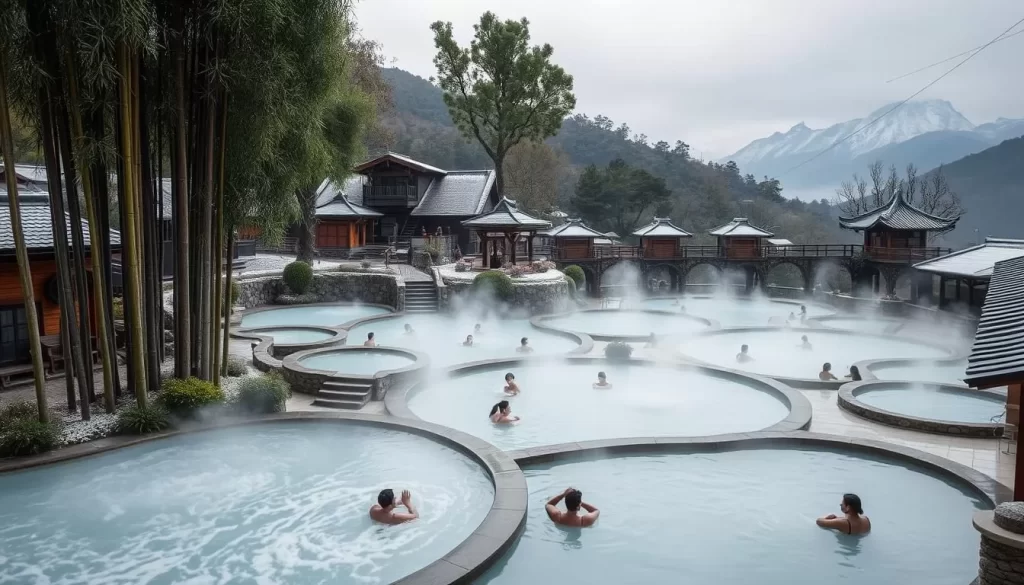
These events are a great way to experience local traditions while enjoying mild weather. The cooler temperatures and lower humidity make outdoor activities like hiking and sightseeing more comfortable.
Spring Delights: Cherry Blossoms and Outdoor Adventures
Spring is a favorite time for many visitors, thanks to the stunning cherry blossoms. Places like Yangmingshan National Park come alive with pink and white blooms, creating a picturesque setting. Temperatures during this season range from 16°C in the north to 28°C in the south, making it ideal for outdoor adventures.
Whether you’re exploring national parks or strolling through flower festivals, the pleasant weather enhances every experience. Spring also sees lower rainfall, so you can plan your activities with confidence.
“Spring is nature’s way of saying, ‘Let’s party!’” – Robin Williams
From hiking trails to cultural events, spring offers a mix of natural beauty and vibrant energy. It’s a season that appeals to both nature lovers and festival enthusiasts.
Taiwan: Best Months for a Weather-Savvy Trip
Weather plays a crucial role in shaping your travel experience. By understanding seasonal patterns, you can choose the ideal time to visit and enjoy comfortable conditions. Let’s dive into a comparative analysis of weather and the benefits of traveling during optimal months.
Comparative Weather Analysis
From October to April, the island experiences lower humidity and minimal rain, making it the perfect window for exploration. During these months, temperatures range from 16°C to 29°C (61°F to 84°F), offering a pleasant balance between warmth and coolness. In contrast, summer months (June-August) bring intense heat, with temperatures often exceeding 35°C (95°F) and higher humidity levels.
Rainfall is another key factor. June is the wettest month, with an average of 500mm of rain, while December and January see only around 20mm. This stark difference makes autumn and winter the preferred seasons for outdoor activities and sightseeing.
Travel Benefits During Optimal Months
Traveling between October and April not only ensures better weather but also offers significant cost savings. Accommodation prices during this period are 30-50% lower compared to peak summer months. Flights and attractions are also more affordable, making it easier to stick to your budget.
Additionally, off-peak travel means fewer crowds and easier booking. You can secure accommodations and tours without the stress of last-minute planning. However, it’s worth noting that specific events like the Lunar New Year may cause temporary spikes in prices and availability.
| Month | Average Temperature (°C) | Rainfall (mm) | Travel Benefits |
|---|---|---|---|
| October | 22-29 | 50 | Lower prices, mild weather |
| December | 16-25 | 20 | Festive events, fewer crowds |
| April | 20-28 | 60 | Spring blooms, pleasant temperatures |
By analyzing temperature, rainfall, and humidity, you can plan a trip that aligns with your preferences. Whether you’re chasing sunny skies or cool mountain breezes, the island offers something for every traveler.
Planning Your Itinerary Around Taiwan’s Festivals
Immerse yourself in the vibrant culture by aligning your trip with local festivals. These events offer a unique glimpse into traditions and create unforgettable memories. Whether you’re visiting in spring, summer, autumn, or winter, there’s always something to celebrate.

Cultural Celebrations and Local Events
From the Lunar New Year to the Pingxi Sky Lantern Festival, each event reflects the rich heritage of this destination. The Lunar New Year, celebrated in January or February, is a time of family reunions and vibrant parades. Meanwhile, the Pingxi Sky Lantern Festival in February or March lights up the night sky with thousands of glowing lanterns.
These festivals not only showcase traditions but also bring communities together. Participating in these events allows you to connect with locals and experience their way of life. Be sure to check the dates and plan ahead, as these celebrations often attract large crowds.
Seasonal Festivals and Holiday Trends
Each season brings its own set of festivals, making it a year-round destination for travelers. In spring, the cherry blossoms create a picturesque backdrop for events like the Yangmingshan Flower Festival. Summer is marked by lively beach parties and cultural performances, while autumn offers harvest festivals and lantern displays.
Winter is a magical time, with events like the Lantern Festival and hot spring celebrations. These festivals often coincide with holidays, so expect higher tourist activity during these periods. To avoid booking challenges, consider planning your trip a few months in advance.
- Spring: Cherry blossom festivals and outdoor events.
- Summer: Beach parties and cultural performances.
- Autumn: Harvest celebrations and lantern displays.
- Winter: Lantern Festival and hot spring gatherings.
By aligning your itinerary with these festivals, you’ll gain a deeper appreciation for the culture and traditions. Whether you’re a first-time visitor or a seasoned traveler, these events will make your trip truly special.
Tips for a Weather-Smart Packing List
Packing smartly ensures you’re ready for any weather changes during your trip. With diverse climates across regions, your packing list should include versatile clothing and essential accessories. This guide will help you prepare for everything from sunny beach days to cooler mountain excursions.
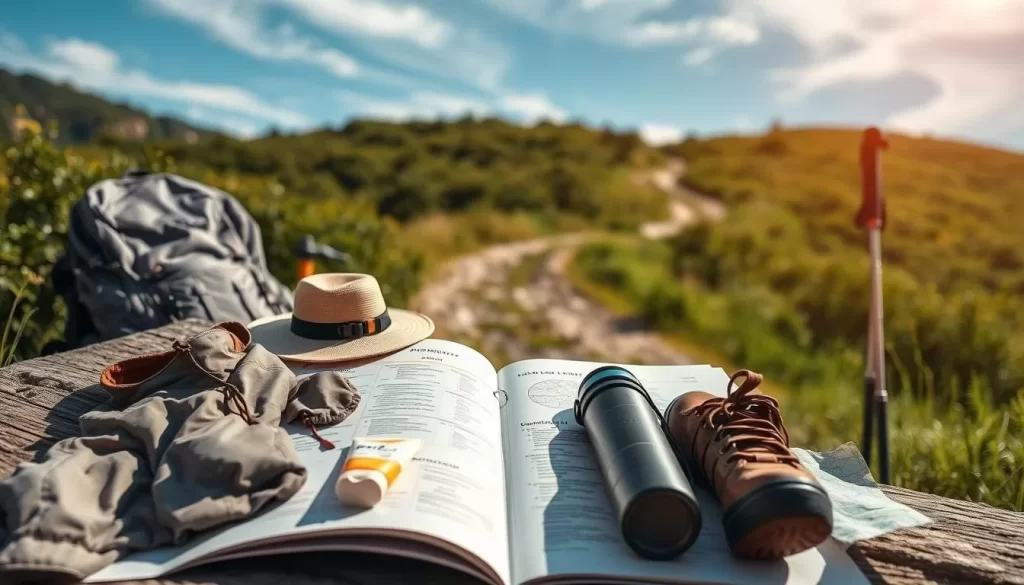
Clothing Essentials for Varied Climates
When traveling, lightweight and moisture-wicking fabrics like cotton and linen are ideal for warmer days. These materials keep you comfortable in high humidity and heat. For cooler areas, pack layers such as long-sleeve shirts, sweaters, and a lightweight jacket. This approach lets you adapt to changing temperatures throughout the day.
If you’re visiting during the summer, quick-dry swimwear is a must for beach outings. For winter trips, insulated jackets and thermal underwear provide extra warmth. Neutral colors like black, gray, and beige allow for mix-and-match outfits, maximizing your wardrobe options.
Accessories and Rain Gear
Sudden rain is common, especially during the monsoon season. A compact umbrella and a waterproof jacket are essential to stay dry. For added convenience, consider packing a lightweight daypack to carry these items during day trips.
Proper footwear is another key consideration. Casual sneakers work well for urban exploration, while hiking shoes are better for nature trails. Don’t forget compression socks for long flights to improve circulation and comfort.
- Lightweight, moisture-wicking clothing for warm weather.
- Layers for cooler temperatures in mountainous areas.
- Waterproof jacket and compact umbrella for sudden rain.
- Quick-dry swimwear for beach visits.
- Neutral-colored outfits for versatile styling.
For more detailed packing tips, check out this comprehensive guide. By packing smartly, you’ll stay comfortable and prepared, no matter the weather.
Navigating Tourist Seasons and Budget Considerations
Planning your trip during the right season can make all the difference. By understanding when to visit, you can save money, avoid crowds, and enjoy better weather. Let’s explore how to make the most of off-peak travel and handle busy periods like a pro.
Off-Peak Travel Benefits
Traveling between November and March (excluding peak holiday weeks) offers significant advantages. During this time, you’ll find lower prices on accommodations and flights, with savings of up to 50% compared to peak summer months. Fewer tourists also mean shorter lines at attractions and a more relaxed experience.
The weather during these months is another perk. Cooler temperatures and minimal rain make it ideal for exploring cities and nature spots. Whether you’re strolling through urban streets or hiking in national parks, the conditions are comfortable and enjoyable.
Handling Crowds and Booking Tips
If you’re traveling during busier periods, planning ahead is essential. Book accommodations and transportation early, especially around major holidays like Lunar New Year. This ensures you secure the best options and avoid last-minute stress.
Flexibility is key to making the most of your trip. Consider adjusting your itinerary to include less crowded areas or visiting popular spots during off-peak hours. For more tips on budget-friendly travel, check out this comprehensive guide.
- Travel during November-March for lower costs and fewer crowds.
- Book accommodations and transportation early for busy periods.
- Enjoy cooler temperatures and minimal rain during off-peak months.
- Stay flexible to maximize your budget and experience.
By aligning your travel plans with the right season, you can enjoy a stress-free and budget-friendly adventure. Whether you’re exploring vibrant cities or serene landscapes, timing your trip wisely ensures a memorable experience.
Exploring Taiwan’s Top Destinations in Every Season
Discover the perfect blend of urban energy and natural serenity as you explore this vibrant destination. From bustling cities to tranquil national parks, there’s something for every traveler. Whether you’re drawn to cultural landmarks or scenic trails, the season you visit will shape your experience.
Urban Adventures in Taipei and Kaohsiung
In the north, Taipei offers a mix of modern amenities and cultural treasures. Visit the vibrant night markets for a taste of local street food, or explore museums that showcase the region’s history. The city is alive with energy, especially during spring when cherry blossoms add a touch of color.
Down south, Kaohsiung is known for its sunny weather and waterfront attractions. With over 300 days of sunshine each year, it’s a great place to enjoy outdoor activities. Don’t miss the bustling brunch spots that cater to every taste.
Nature Escapes in National Parks and Mountains
For a break from the city heat, head to Taroko National Park. Its marble canyons and scenic trails are a hiker’s paradise. In the cooler months, the park’s lush landscapes are even more inviting.
Alishan, in the central highlands, is another must-visit. Known for its misty forests and sunrise views, it’s a peaceful retreat year-round. Spring is especially magical, with cherry blossoms painting the area in soft hues.
No matter the season, this destination offers endless opportunities for adventure. For more tips, check out this .
Local Insights: What to Expect Each Month
Understanding the monthly weather patterns can help you make the most of your trip. Each month brings unique temperature shifts, rain patterns, and events that shape your experience. From brisk winters to humid summers, here’s what you need to know.
Unique Climatic Shifts Throughout the Year
Spring, from March to May, is marked by mild weather and occasional rain. This is when the plum rains begin, bringing short bursts of showers. Summer, from June to August, is hot and humid, with temperatures often exceeding 30°C (86°F).
Autumn, from September to November, offers cooler temperatures and clear skies. It’s an ideal time for outdoor activities. Winter, from December to February, is cooler, with temperatures ranging from 1°C to 10°C (34°F to 50°F).
Typhoons are common from August to September, bringing heavy rain and strong winds. Being aware of these shifts helps you plan accordingly.
Traveler Tips for a Smooth Experience
Pack layers for unpredictable weather, especially during spring and autumn. A waterproof jacket is essential for sudden rain. During summer, lightweight clothing and hydration are key to staying comfortable.
For winter trips, bring warm layers and insulated jackets. If you’re visiting during typhoon season, keep an eye on weather updates and adjust your itinerary as needed.
Local insights can be invaluable. For example, January and February are quieter months, offering fewer crowds and a more relaxed experience. If you’re planning a trip during this time, check out this guide for more tips.
“The key to a great trip is preparation. Knowing what to expect each month ensures a stress-free adventure.”
By understanding these monthly variations, you can tailor your trip to suit your preferences and enjoy a seamless experience.
Conclusion
To make the most of your journey, understanding the climate and cultural events is essential. Planning your travel around favorable weather and local festivals ensures a memorable experience. From cool mountain breezes to sunny beaches, each region offers unique opportunities depending on the time of year.
Flexibility is key. Adjusting your itinerary for seasonal changes and regional differences allows you to enjoy everything from hot springs to cherry blossoms. Use this guide to make informed decisions about your trip, ensuring you’re prepared for any weather surprises.
For those considering a longer stay, explore the digital nomad lifestyle in Taiwan, which combines work and exploration seamlessly. With these insights, your visit will be both enjoyable and perfectly timed.
The above is subject to change.
Check back often to TRAVEL.COM for the latest travel tips and deals.

